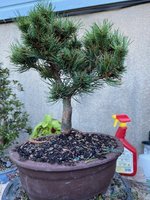@Dav4 I have an import permit from the USDA to import the Genus Pinus (2 & 3 needle pine is banned) and Rhododendrum indicum. My permit is specific only to Japan. While what you copied above is true, the USDA has a plant book that further breaks down what is and what is not authorized in terms of importation. For Japan importation of seeds from the Genus Pinus spp. is not regulated, only live plant material is. However the importation of 2 or 3 needle pine from Japan is forbidden. 5 needle pine is authorized, but there is further regulations onto the caliper of the trunk/stem. All live material requires a phytosanitary certificate to ensure no pests or deceases are introduced onto US soil.
There was a thread a while back on here about a member ordering some seeds and the seeds got confiscated from the USDA at customs and then wanting to blame the seller. In all actuality it's the members fault for not researching what is or isn't required to import those seeds....first if it is even authorized, second the species, third from that country. It can get complicated which is why people don't want to spend the time to inform themselves of the regulations. That's why if you want to play in the game you have to know the rules. If you follow the rules "Big Brother" can't really do anything as they make the rules for us to follow.
One example....... Importation of 2 or 3 needle pine from Japan is forbidden. However importation of 2 or 3 needle pine is authorized from South Korea with a phytosanitary certificate......but upon arrival onto US soil the plants must quarantine in an authorized and approved holding area that must be separated from any other plant material by a certain distance for a certain amount of time......and you must accept regular inspections from the USDA announce and unannounced.
So if you can source out some JWP seed, get some for me too! The only issue with JWP seed is that their viability rate drops fast if not stored properly. You can order a couple of pounds of seed and if those seeds are left out in the sun or a hot warehouse you could loose 50% or more of the seed. Then when it's time to sow and you get a poor germination rate you think you got bad seeds when in all actuality the seeds were good while the storage wasn't. If I could find a source I wouldn't mind ordering a few pounds, but it's what I mentioned above about the storage that concerns me.


